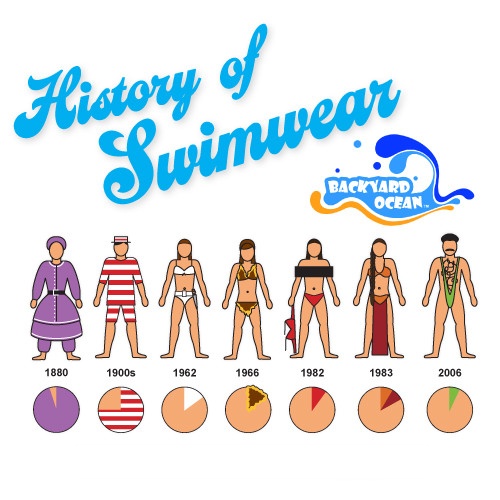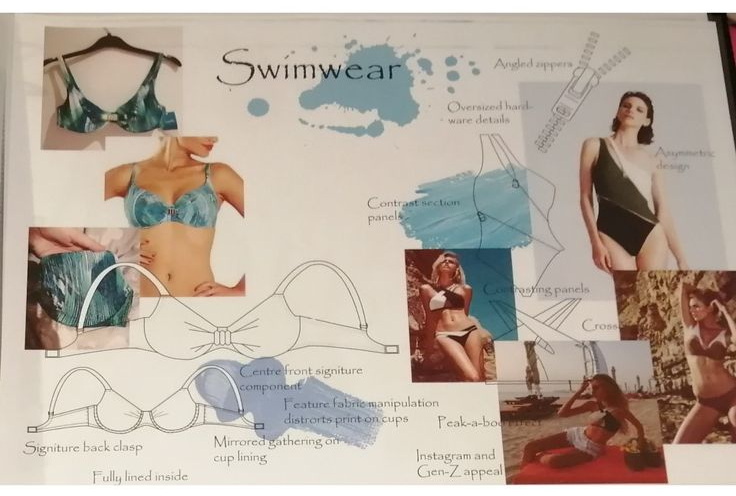Content Menu
● Introduction to Modern Swimwear
>> The Evolution of Swimwear
>> Why Discuss Swimwear Trends?
● The Historical Tide of Swimwear
● Current Swimwear Trends
>> Minimalist Swimsuits
>> Bold and Bright Colors
>> Retro Revival
>> The Shrinking Trend
● Cultural Waves: The Impact of Swimwear on Society
● Body Image: The Double-Edged Sword of Revealing Swimwear
● Market Currents: The Business of Swimwear
● Technological Tides: Innovations in Swimwear Design
● The Future Shore: What's Next for Swimwear?
● Are Swimsuits Getting Smaller?
>> The Rise of the Bikini
>> Comfort and Freedom
>> Fashion Statements
● Designing Swimwear
>> Choosing Materials
>> Design Elements
>> Sustainability in Design
● Conclusion: The Ebb and Flow of Swimwear Trends
● Common Questions About Swimwear
Discover the trend behind shrinking swimsuits and the surprising reasons why beachwear is getting smaller each year. Find out now!
As we bask in the sun on sandy shores or lounge by poolsides, one cannot help but notice the ever-changing landscape of swimwear fashion. The question on many minds is: Are swimsuits getting smaller? To answer this, we must dive into the fascinating world of beach attire, exploring its rich history, cultural significance, and the myriad factors influencing its evolution.
Introduction to Modern Swimwear
Swimwear is something we all think about during summer. When the sun shines, and the beach calls, we want to look our best in our swimsuits. But have you ever wondered how swimsuits have changed over time? This is a really interesting topic for summer beachwear enthusiasts!
The Evolution of Swimwear
Long ago, swimsuits looked very different. In the past, they were made of heavy materials and covered almost everything. People wore big, baggy suits that weren't very fun or colorful. As time went on, swimsuits started to change. Designers began to create lighter materials and fun styles. Today, we have many options that are stylish, comfortable, and allow us to express our personalities at the beach.
Why Discuss Swimwear Trends?
Talking about swimwear trends is important, especially for those who love summer beachwear. Trends can show us what's popular and help us make cool choices when shopping. By keeping up with these trends, we can find swimsuits that not only look good but also feel great. Plus, it's always fun to see what new styles are out there for our beach adventures!
The Historical Tide of Swimwear
The story of swimwear is a tale of liberation, innovation, and societal change. From the modest bathing gowns of the 18th and 19th centuries to the daring bikinis of the mid-20th century, swimsuits have undergone a remarkable transformation.
In the early 1900s, swimwear was primarily functional, designed for modesty rather than style or comfort. Women's swimsuits often resembled dresses, complete with bloomers and stockings. Men's swimwear, while less restrictive, still covered most of the body.

The 1920s marked a turning point in swimwear design. As social norms began to relax, swimsuits became more form-fitting and revealed more skin. The iconic one-piece swimsuit emerged, revolutionizing beach fashion and setting the stage for future innovations.
The 1940s and 1950s saw the birth of the bikini, a watershed moment in swimwear history. Designed by French engineer Louis Réard in 1946, the bikini was named after the Bikini Atoll, where atomic bomb tests were conducted. The explosive impact of this tiny two-piece was felt around the world, challenging societal norms and redefining beach attire.

Current Swimwear Trends
This summer, lots of fun styles are making waves in the world of swimwear trends. Whether you're hitting the beach or the pool, there's a swimsuit out there just for you. Let's dive into some of the coolest swimwear trends right now and see what makes each style special.
Minimalist Swimsuits
One of the biggest trends this season is minimalist swimsuits. These swimsuits are all about keeping it simple. They often have clean lines and fewer details, which makes them super stylish. Many people love minimalist swimsuits because they are easy to wear and look fresh. You don't need a lot of frills to make a statement when you can rock a chic and simple design!
Bold and Bright Colors
This summer, bold and bright colors are everywhere! Swimsuits in neon pink, electric blue, and sunny yellow are stealing the spotlight. These colors are perfect for standing out at the beach or pool. Bright colors can make you feel happy and full of energy, which is exactly what summer beachwear is all about. So, if you want to turn heads, pick a swimsuit that really pops!
Retro Revival
Another exciting trend is the retro revival. This means that styles from the past are coming back in a big way! Think about the high-waisted bikinis and colorful floral patterns that were super popular in the 80s and 90s. Many designers are taking inspiration from these classic looks and giving them a modern twist. Wearing a retro swimsuit is a fun way to show off your style while celebrating the history of swimwear.
The Shrinking Trend
From the 1960s onwards, there has been a general trend towards smaller, more revealing swimwear. The string bikini gained popularity in the 1970s, pushing the boundaries of minimalism in beach fashion. High-cut swimsuits of the 1980s and the thong bikinis of the 1990s continued this trajectory, leaving little to the imagination.
However, it's important to note that the trend towards smaller swimwear has not been linear or universal. In recent years, there has been a resurgence of more modest styles, including high-waisted bikinis and one-piece swimsuits. This diversity in swimwear options reflects a broader cultural shift towards body positivity and inclusivity.
Cultural Waves: The Impact of Swimwear on Society
The evolution of swimwear is inextricably linked to changing social norms and cultural attitudes. As swimsuits have become smaller, they have both reflected and influenced societal views on modesty, body image, and gender roles.
In many ways, the shrinking swimsuit has been a symbol of women's liberation. The ability to wear less at the beach has been associated with increased freedom and control over one's body. However, this has also led to debates about objectification and the pressure to conform to certain beauty standards.
The impact of swimwear on popular culture cannot be overstated. From Ursula Andress's iconic white bikini in the James Bond film "Dr. No" to the red swimsuits of "Baywatch," swimwear has played a starring role in shaping cultural ideals of beauty and sex appeal.
Body Image: The Double-Edged Sword of Revealing Swimwear
As swimsuits have become smaller, they have put increased focus on the body. This has had both positive and negative effects on body image and self-esteem.
On one hand, the trend towards more revealing swimwear has encouraged many people to embrace their bodies and feel confident in their skin. The body positivity movement has gained momentum, challenging traditional beauty standards and promoting acceptance of all body types.
On the other hand, the prevalence of small, form-fitting swimwear has also contributed to body image issues for many individuals. The pressure to achieve a "beach-ready body" can lead to unhealthy behaviors and negative self-perception.
The fashion industry has begun to respond to these concerns, with many brands now offering a wider range of sizes and styles to cater to diverse body types. This shift towards inclusivity is a positive step in promoting healthier attitudes towards body image.
Market Currents: The Business of Swimwear
The swimwear market is a multi-billion dollar industry, driven by changing fashion trends, technological innovations, and shifting consumer preferences. As of 2023, the global swimwear market was valued at approximately $20.7 billion, with projections for continued growth.
The trend towards smaller swimwear has had a significant impact on the market. Manufacturers have had to adapt to changing consumer demands, developing new materials and designs to create ever-more revealing yet comfortable and functional swimsuits.
However, the market is not monolithic. While there is still strong demand for smaller, more revealing styles, there has also been growth in the market for modest swimwear. This includes burkinis, swim dresses, and other styles that offer more coverage, catering to diverse cultural and personal preferences.
Sustainability has also become a key concern in the swimwear industry. As consumers become more environmentally conscious, there is increasing demand for swimsuits made from recycled materials or produced using eco-friendly methods.
Technological Tides: Innovations in Swimwear Design
Advancements in textile technology have played a crucial role in the evolution of swimwear. The development of synthetic fibers like nylon and spandex in the mid-20th century revolutionized swimsuit design, allowing for more form-fitting and durable garments.
More recent innovations have focused on enhancing performance and comfort. UV-protective fabrics, quick-drying materials, and chlorine-resistant textiles are just a few examples of how technology is shaping modern swimwear.
3D printing technology is also making waves in the swimwear industry, allowing for custom-fit swimsuits and unique designs that were previously impossible to produce.
The Future Shore: What's Next for Swimwear?
As we look to the future, it's clear that the evolution of swimwear is far from over. While the trend towards smaller swimsuits may continue in some sectors, it's likely that we'll see even greater diversity in styles and sizes.
Personalization is likely to be a key trend, with advancements in technology allowing for custom-fit swimwear tailored to individual body shapes. We may also see the integration of smart technology into swimwear, such as UV sensors or performance-tracking capabilities.
Sustainability will undoubtedly play a crucial role in shaping the future of swimwear. Expect to see more eco-friendly materials and production methods, as well as initiatives to reduce waste in the industry.
Are Swimsuits Getting Smaller?
Many people wonder, "Are swimsuits getting smaller?" This is an interesting question, especially when we look at bikini fashion and the types of swimsuits people wear today. Over the years, swimwear has changed a lot, and one of the noticeable changes is that swimsuits seem to be getting smaller. Let's dive into this topic and explore why that might be happening.
The Rise of the Bikini
The bikini has a fascinating history. It was first introduced in the 1940s and was quite different from the swimsuits of that time. Early bikinis were much smaller than traditional swimsuits, and over the decades, they have continued to get smaller. This trend began because many people wanted to be more comfortable at the beach and show off their bodies in a fun way. As a result, bikini fashion has changed, and now we see many different styles that are even tinier than before!
Comfort and Freedom
Why do some people like smaller swimsuits? One reason is comfort. Minimalist swimsuits, which are designed to cover less skin, can help you feel freer when you swim or play in the water. With less fabric, there's less to hold you back. This can make swimming and playing at the beach a lot more enjoyable, especially on hot summer days.
Fashion Statements
Wearing smaller swimsuits can also be a bold fashion statement. Many people enjoy expressing their style through swimwear. Choosing a smaller bikini can show confidence and allow individuals to stand out on the beach. It's like wearing a piece of clothing that tells others, "I love who I am!" This idea of self-expression is important to many, especially in the world of swimwear design.
Designing Swimwear
Designing swimwear is a fun and creative process. It involves thinking about how the swimsuit will look, feel, and fit. Designers must create swimwear that is not only stylish but also comfortable and practical for water activities. Let's dive into the key parts of swimwear design!
Choosing Materials
The first step in swimwear design is choosing the right materials. Swimsuits are usually made from special fabrics like nylon and spandex. These materials are stretchy, which helps the swimsuit fit snugly on the body. They also dry quickly, making them perfect for swimming and sunbathing. Some designers are even using recycled materials to create eco-friendly swimwear. This way, they help protect our oceans while making stylish pieces!
Design Elements
Next, it's all about the design elements. Swimwear can come in many shapes and styles. The cut of a swimsuit is very important. For example, bikinis have two pieces and can show more skin, while one-piece swimsuits cover more. Designers also think about colors and patterns. Bright colors can make a swimsuit stand out, while fun patterns can add a playful touch. Every detail counts in making a swimsuit unique!
Sustainability in Design
Finally, sustainability is a big topic in swimwear design today. More designers are focusing on how to create swimwear that is good for the environment. This means using materials that are better for the planet and making swimsuits that last longer. By doing this, designers not only create beautiful swimsuits but also help keep our beaches and oceans clean for future generations to enjoy.
Conclusion: The Ebb and Flow of Swimwear Trends
So, are swimsuits getting smaller? The answer is not a simple yes or no. While there has been a general trend towards more revealing swimwear over the past century, this trend is neither universal nor irreversible. Today's swimwear market offers a diverse range of options, from the tiniest string bikinis to full-coverage swim dresses.
The evolution of swimwear reflects broader societal changes in attitudes towards the body, sexuality, and personal freedom. As we continue to navigate these cultural currents, one thing is certain: the story of swimwear is far from over. Whether big or small, modest or revealing, swimsuits will continue to make waves in fashion and culture for years to come.

Common Questions About Swimwear
Q: Are smaller swimsuits more popular than ever?
A: While there is still demand for smaller swimsuits, the trend is not universal. There's a growing market for diverse styles, including more modest options. The popularity of different styles varies depending on cultural norms, personal preferences, and current fashion trends.
Q: How has technology influenced swimwear design?
A: Technology has greatly impacted swimwear design through the development of new materials like spandex, innovations in UV protection and quick-drying fabrics, and the use of 3D printing for custom designs. These advancements have improved both the functionality and comfort of swimwear.
Q: What are some current trends in swimwear?
A: Current trends include high-waisted bikinis, one-piece swimsuits with cutouts, sustainable swimwear made from recycled materials, and inclusive sizing options. There's also a trend towards versatile pieces that can be worn both in and out of the water.
Q: How has the body positivity movement affected swimwear?
A: The body positivity movement has led to more diverse representation in swimwear advertising and a wider range of sizes and styles being offered by brands. It has encouraged the celebration of all body types and challenged traditional beauty standards in beach fashion.
Q: Are there cultural differences in swimwear preferences around the world?
A: Yes, swimwear preferences can vary significantly across different cultures. While smaller swimsuits might be common in some Western countries, more conservative styles are preferred in other parts of the world. Many brands now offer region-specific collections to cater to these diverse preferences.
Q: Why are swimsuits getting smaller?
A: Swimsuits are getting smaller for a few reasons. One big reason is that many people enjoy wearing bikini fashion because it lets them show off their bodies. Smaller swimsuits can also feel more comfortable and give you more freedom to move. When you're swimming or playing at the beach, having less fabric can help you feel light and free, just like a superhero flying through the air! Plus, smaller swimsuits are a way to make a bold fashion statement. They show confidence and a fun attitude about summer beachwear.
Q: How do I choose the right swimsuit for my body type?
A: Choosing the right swimsuit for your body type is important so that you feel great while wearing it. First, know your shape! If you are curvy, you might want a swimsuit that offers more support, like a bikini with a thicker band. If you are more straight-shaped, you can try minimalist swimsuits that add curves, like ruffles or patterns. Remember, comfort is key! You should feel happy and confident, so always pick a swimsuit that you feel good in. Don't be afraid to mix and match tops and bottoms to find your perfect style!
Q: What materials are best for swimwear?
A: The best materials for swimwear are those that are stretchy, quick-drying, and comfortable. Popular options include polyester and spandex. These materials help your swimsuit fit snugly and keep its shape, so you can swim easily. Some swimwear is made from recycled materials, which is great for the planet! When choosing a swimsuit, look for something that feels soft on your skin and dries fast when you get out of the water. This way, you can have fun at the beach without worrying about being wet for too long!




































